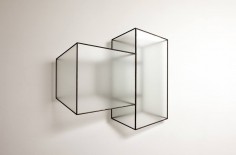REINOUD OUDSHOORN
source: highlike
Work: 2010 77 x 86 x 26 cm Frosted glass and iron
Photographer: Rob van Uchelen
.
.
.
.
.
.
.
source: patrickheide
A painter in his early career, Ousdhoorn takes the illusionary language of painting and applies it to sculpture to form a bridge between the spatial illusion of a flat surface and the concrete reality of a physical object.
Space and transparency as well as a desire for harmony and the classic rules of perspective are all ingredients that play a major role in the work of Reinoud Oudshoorn.
Inspired by the “spiritual” painters of abstract expressionism such as Barnett Newman, Mark Rothko and Ellsworth Kelly, Oudshoorn is equally trying to create a level of perception that resembles a state of consciousness, where the immaterial transcends to the physical and not vice versa.
Oudshoorn seeks ways to give viewers the physical experience of the totality of space through a relatively small object. “A work must produce more space than it consumes” as the artist explains himself.
The Dutch sculptor achieves this partly through the materials and compositions chosen, but the idiosyncratic feature is to systematically apply the same vanishing point in all his recent sculptures, always at 1,65 meters. The vanishing point generally alludes to the invisible world that lies behind the point where all lines converge, in Oudshoorn’s sculptures it suggests an endlessness in the space that surrounds us, an infinity of mind and sphere.
At the very beginning Oudshoorn’s sculptures take shape by staring at a white surface, a piece of paper, an empty wall or into dense fog. From a cross fertilization of the white emptiness and the artists’ imagination and experience, shapes of potential sculptures emerge, such as clouds, arches, windows or water surfaces, which find their first concrete form in preliminary sketches. Oudshoorn then develops the sculpture further through precise technical drawings, which include all calculations of the desired vanishing point for that particular shape, to then be transformed into a physical object that is always hand made and unique.
Ousdhoorn’s sculptures are often made with iron and frosted glass, the latter a symbol of the contemplative, metaphysical and mysterious, atmospherically reminiscent of the muffled silence of mist and tying in with the artist’s wish to transport a visual image into a space of one’s own imagination.
Other sculptures are purely made of wood or even steel, two of the latter, amongst them a spider-like corner piece, will be exhibited in London next to three frosted glass sculptures.
Working with a wide range of media, Myrianthe Sozou’s body of work is equally focused on a sculptural and spatial approach to art.
MicroOptasia, a curtain-like wall hanging made of thousands of silver pins, and Focal length 300mm, made from sheeted convex and concave lenses, are site-specific installations that demonstrate the artist’s interest in industrial mass materials and their distorting, mirroring and ultimately alienating qualities. Both works play with our visual systems and human perception while adhering to a somewhat minimal formal stringency.
Myrianthe Sozou was born in 1987 in London. She is graduating from the Art and Science MA program at Central St Martins this year.
.
.
.
.
.
.
.
source: galerieramakers
Reinoud Oudshoorn gebruikt perspectief, afkomstig uit de illusionaire taal van de schilderkunst en gebruikt die in zijn beelden. Op die manier wil hij een brug slaan tussen de ruimtelijke illusie van het platte vlak en de concrete realiteit van het driedimensionale beeld Oudshoorn’s beelden ontstaan vanuit het staren en kijken naar een wit vlak, dat geleidelijk in een ruimte verandert. Daaruit komen tekeningen voort. De keuze voor een materiaal hangt samen met de gekozen tekening en met de technische mogelijkheden: ijzer verwijst naar grafiet, hout is interessant vanwege de lijnen van de nerf, matglas geeft diepte. Een schilderij is hem teveel een illusie en een driedimensionaal beeld teveel realiteit. Hij heeft een tussenvorm gevonden in beelden die ruimte creëren, soms aan een muur, soms op de vloer. Het verdwijnpunt, dat in vrijwel al zijn grotere werken aanwezig is, ligt op 1 m 65 ooghoogte, zodat op elke tentoonstelling een voelbare horizon ontstaat.


